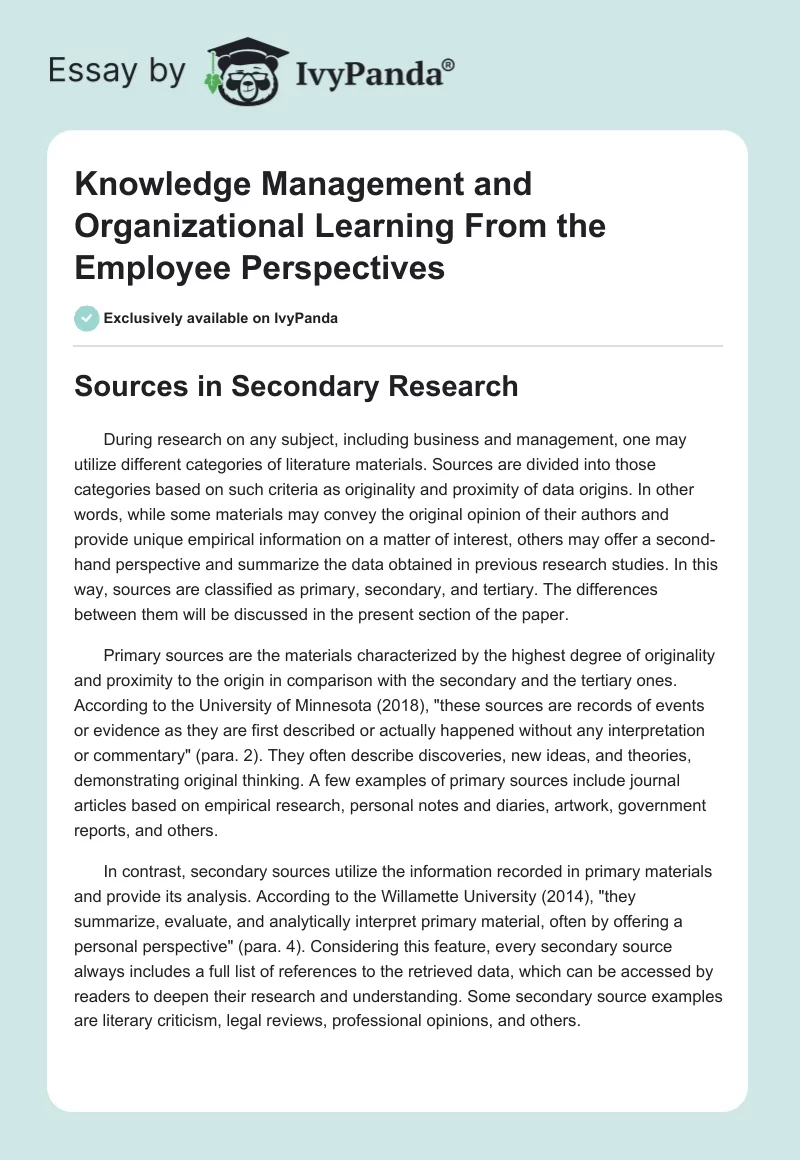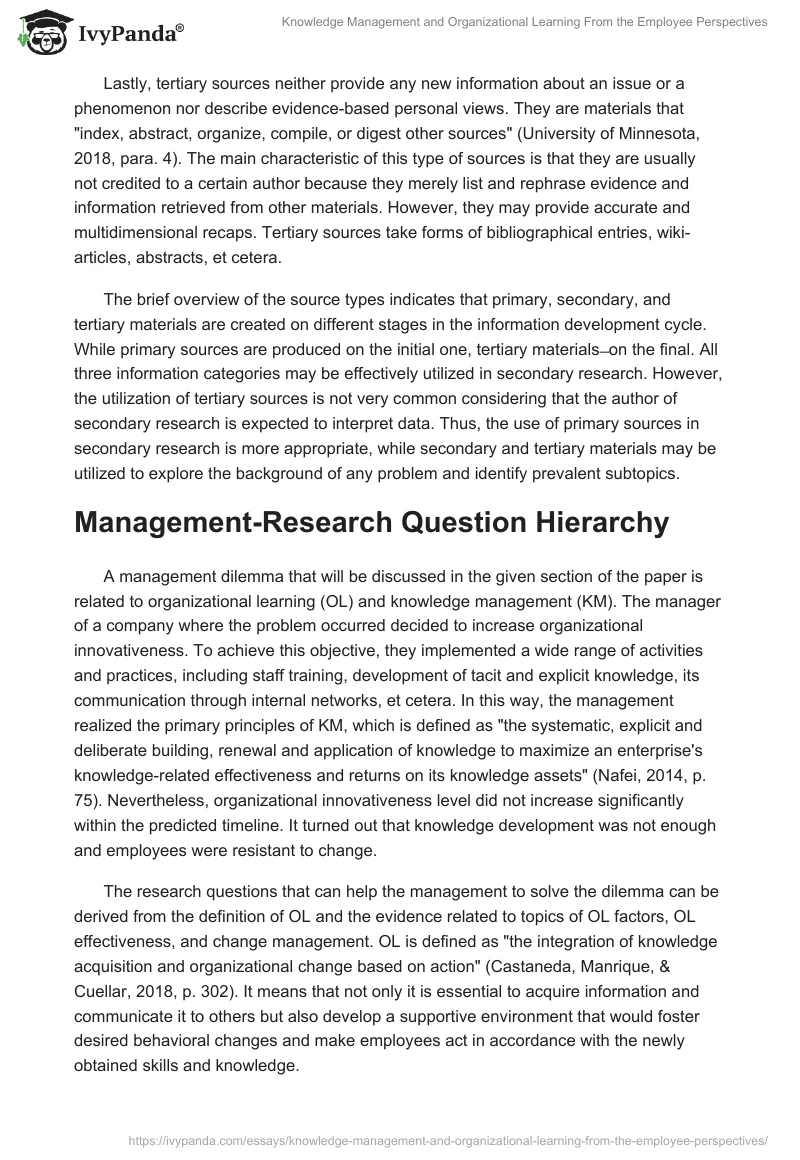Sources in Secondary Research
During research on any subject, including business and management, one may utilize different categories of literature materials. Sources are divided into those categories based on such criteria as originality and proximity of data origins. In other words, while some materials may convey the original opinion of their authors and provide unique empirical information on a matter of interest, others may offer a second-hand perspective and summarize the data obtained in previous research studies. In this way, sources are classified as primary, secondary, and tertiary. The differences between them will be discussed in the present section of the paper.
Primary sources are the materials characterized by the highest degree of originality and proximity to the origin in comparison with the secondary and the tertiary ones. According to the University of Minnesota (2018), “these sources are records of events or evidence as they are first described or actually happened without any interpretation or commentary” (para. 2). They often describe discoveries, new ideas, and theories, demonstrating original thinking. A few examples of primary sources include journal articles based on empirical research, personal notes and diaries, artwork, government reports, and others.
In contrast, secondary sources utilize the information recorded in primary materials and provide its analysis. According to the Willamette University (2014), “they summarize, evaluate, and analytically interpret primary material, often by offering a personal perspective” (para. 4). Considering this feature, every secondary source always includes a full list of references to the retrieved data, which can be accessed by readers to deepen their research and understanding. Some secondary source examples are literary criticism, legal reviews, professional opinions, and others.
Lastly, tertiary sources neither provide any new information about an issue or a phenomenon nor describe evidence-based personal views. They are materials that “index, abstract, organize, compile, or digest other sources” (University of Minnesota, 2018, para. 4). The main characteristic of this type of sources is that they are usually not credited to a certain author because they merely list and rephrase evidence and information retrieved from other materials. However, they may provide accurate and multidimensional recaps. Tertiary sources take forms of bibliographical entries, wiki-articles, abstracts, et cetera.
The brief overview of the source types indicates that primary, secondary, and tertiary materials are created on different stages in the information development cycle. While primary sources are produced on the initial one, tertiary materials ̶ on the final. All three information categories may be effectively utilized in secondary research. However, the utilization of tertiary sources is not very common considering that the author of secondary research is expected to interpret data. Thus, the use of primary sources in secondary research is more appropriate, while secondary and tertiary materials may be utilized to explore the background of any problem and identify prevalent subtopics.
Management-Research Question Hierarchy
A management dilemma that will be discussed in the given section of the paper is related to organizational learning (OL) and knowledge management (KM). The manager of a company where the problem occurred decided to increase organizational innovativeness. To achieve this objective, they implemented a wide range of activities and practices, including staff training, development of tacit and explicit knowledge, its communication through internal networks, et cetera. In this way, the management realized the primary principles of KM, which is defined as “the systematic, explicit and deliberate building, renewal and application of knowledge to maximize an enterprise’s knowledge-related effectiveness and returns on its knowledge assets” (Nafei, 2014, p. 75). Nevertheless, organizational innovativeness level did not increase significantly within the predicted timeline. It turned out that knowledge development was not enough and employees were resistant to change.
The research questions that can help the management to solve the dilemma can be derived from the definition of OL and the evidence related to topics of OL factors, OL effectiveness, and change management. OL is defined as “the integration of knowledge acquisition and organizational change based on action” (Castaneda, Manrique, & Cuellar, 2018, p. 302). It means that not only it is essential to acquire information and communicate it to others but also develop a supportive environment that would foster desired behavioral changes and make employees act in accordance with the newly obtained skills and knowledge.
Based on the findings stated above, the investigative research questions associated with the identified management problem will be as follows: What managerial, cultural, social, and psychological barriers exist in the organizational environment and interfere with the change process? What environmental factors contribute to greater innovativeness and foster change? What specific OL and KM processes can support the change management efforts and what procedures can maximize the favorable OL and KM outcomes? The primary research question is as follows: Will the environment and practices developed in accordance with OL and KM principles and the change management processes built consistently with evidence-based change models help increase organizational innovativeness?
The suggested questions were formulated by using the management-research question hierarchy process. They have a purpose of leading the company’s managers in the investigation of the current dilemma. It started with the identification of the problem and the exploration of research background related to it. Consequently, the questions investigating multiple dimensions of the issue and opportunities were given. Lastly, the main management question was proposed, and it was intended to set forth the research methods and tasks.
References
Castaneda, D. I., Manrique, L. F., & Cuellar, S. (2018). Is organizational learning being absorbed by knowledge management? A systematic review. Journal of Knowledge Management, 22(2), 299-325.
Nafei, W. (2014). Knowledge management and organizational learning from the employee perspectives: A study from Saudi Arabia context. Journal of Management and Strategy, 5(1), 73-87.
University of Minnesota. (2018). Primary, secondary, and tertiary sources. Web.
Willamette University. (2014). Primary, secondary, and tertiary literature. Web.


